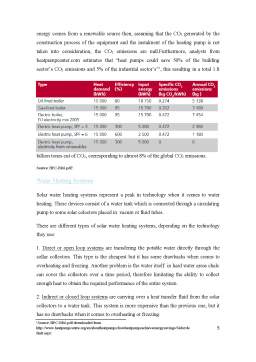Cuprins
- Introduction 2
- Insulation 2
- Heating systems 3
- Water heating systems 5
- Conclusion 6
- Reference list 7
Extras din referat
Introduction
By definition, the term “Climate change” describes any process that alters or modifies the Earth’s weather, including changes in the average temperature worldwide, wind and rainfall patterns or the frequency of different weather events (for example hurricanes).
The UN’s Intergovernmental Panel on Climate Change highlighted the fact that if the rise in greenhouse emissions keeps its growing trend, the best estimate increase in temperature would be +4o C by 2100, a thing which most of the coast residents will not afford.
In order to prevent this hazardous scenario, EU leaders have decided to diminish the emission’s level with 30% by 2020, compared with 1990. In addition to this, all developed countries should cut down their greenhouse emissions with at least 80% until 2050.
Mike Berners1 estimated in his book entitled “How bad are bananas?”, that from the total CO22 emissions of a country, more than 40% come from households, therefore the aim of this assignment is to analyse and compare solutions for cutting some of the CO2 emissions generated by houses. Over 50% of the greenhouse gas emitted by a normal household comes from heating itself and its water.
Insulation
Thermal insulation is a very important factor for obtaining a certain thermal comfort and cutting CO2 emissions dramatically. Its main purpose is reducing the heat transfer between the exterior and the interior of the house. Before describing different types of insulation it is very important to know that insulating a building during construction is cheaper and more environmentally friendly than putting it together after the building has been finished. That is mainly because this thermal shield is usually hidden, therefore if one were to insulate it after the construction process had been finished, new cost and CO2 would have been be generated due to retrofitting.
Whether one chooses to insulate one’s home with vacuum insulated panels, different types of synthetic foam, polystyrene, glass or sheep’s wool, one would have to take into account different factors. One of the most important things to consider is the environmental impact and the total timespan of effectiveness. For example Mike Berners Lee estimated that somewhere around 350kg CO2 is generated by adding 270mm rock wool insulation on a not insulated three bedroom house. However, EST1 estimates that save approximately 800kg CO2 emissions per year can be saved with this type of insulation - that is, 32 tons of CO2 over 40 years.
Another factor is the cost effectiveness. There are some countries where one can get a 50% grant off the total price of the project. Once the house is insulated, one will be able to obtain the same thermal comfort with a less amount of heat generated by a heating system; therefore the heating cost will go down. Other important factors are longevity, flammability and the ease of replacement at end of life.
But insulation is not the only factor that can reduce the greenhouse emissions generated by a house through the heating process. Another important aspect is the building design. A building plan must be created with regard to the geographical position. For example, here in Denmark we are situated in the Northern hemisphere. Therefore, due to the inclination of the planet’s axis the sun will reach his peak point towards the South. So it is highly advised that in a cold climate like Denmark’s, houses should face south. On the other hand, a house situated in a hot climate in the Northern hemisphere should face north; this, combined with a light collared roof and an adequate system of insulation, will help to obtain a lower temperature inside the house. Adding up an energy efficient cooling system will dramatically cut the CO2 emissions and the average cost.
Preview document
Conținut arhivă zip
- Alternate Heating Methods.docx















